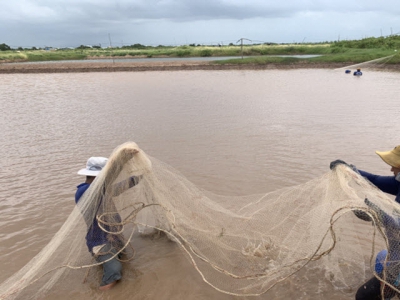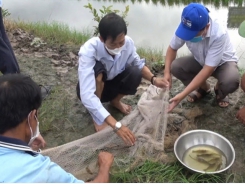Sustainable livelihood model for shrimp farmers in Bac Lieu

Shrimp farming in Bac Lieu province has seen positive changes after implementing a sustainable livelihood and climate change adaptation model.
The current solution for shrimp farming is how to shorten the farming time to save input costs. Photo: Trong Linh.
Risks to face
The sustainable livelihood and climate change adaptation model for shrimp farmers in the south of National Highway 1A has been bringing positive changes to shrimp farming in Bac Lieu.
Many shrimp farms have applied good farming practices and environmental management to adapt to climate change, thus improving the economic efficiency of intensive shrimp farming.
The province’s shrimp farming now sees more advantages and opportunities for development.
Depending on the conditions of families and farming areas, farmers in Bac Lieu province carried out different shrimp farming forms including super-intensive, intensive, semi-intensive or improved extensive and combined extensive farming.
According to experts' assessment, the achieved results have not to tap the potential and advantages of the locality.
Besides sufficient irrigation and electricity systems for production, farmers also face risks and disadvantages relating to climate change impacts, increasing input material prices and unstable farmed shrimp products, inadequate technical applications.
Especially, the overuse of antibiotics and chemicals has left many toxins in the soil and water.
Bac Lieu is a province with advantages and potential for aquaculture, with a total area of nearly 70,000 ha of specialized shrimp farming, accounting for nearly half of the province's total aquaculture area. The shrimp farms were concentrated mainly in coastal localities including Bac Lieu City, Hoa Binh and Dong Hai districts and a part of Gia Rai town.
According to the results of professional periodic monitoring, environmental indicators like Ammonium content, bacteria, mixed algae, F2 and NH3 in estuaries in Bac Lieu are now all exceed the allowable limits. This is the main reason why aquaculture in Bac Lieu province is still not safe and sustainable despite increased productivity and output
Farmer To Minh Dung in Vinh Lac hamlet, Vinh Thinh commune, Hoa Binh district said that his family had shrimp ponds of a total of ten ha.
After being raised for more than seven months of stocking, the shrimp now weighs 20 - 22 head per kg. Compared with the farming seasons in previous years, this year’s conditions are harsher, so shrimp grew slow and the farming time is longer.
In 2020, it only took about 6.5 months for shrimp to reach the size of 20-22 head/kg.
In Hoa Binh District - one of the four localities with a fairly large shrimp farming area in Bac Lieu, shrimp farmers implemented models such as improved extensive, semi-intensive, intensive and super-intensive farming.
In recent years, the shrimp farming environment has been increasingly polluted by improperly-treated waste from companies, production and processing establishments.
Moreover, before taking water into shrimp ponds, farmers also use banned chemicals, which affects the current shrimp farming environment.
Sub-project 10
In 2020, based on the Project on Integrated Climate Resilience and Sustainable Livelihoods in the Mekong Delta region, Sub-project 10 was approved for implementation in Bac Lieu Province.
Under the sub-project, resilient infrastructure is improved to serve the protection and development of ecological forests, improve livelihoods and climate change adaptation in Hoa Binh, Dong Hai and Bac Lieu districts.
Nguyen Van Hung, Head of Technical Department under the province’s Agricultural Extension Centre said that in recent years, the aquaculture industry of the province faced many difficulties, particularly the negative impacts of climate change.
The unfavourable weather caused high risks to shrimp farming.
Sub-project 10 was implemented to help shrimp farmers improve and reduce risks, he said.
During its implementation, the agricultural sector of Bac Lieu province focused on transferring science and technology to the people through training courses, introducing solutions to help shrimp farming households overcome difficulties.
For example, the Agricultural Extension Centre guided shrimp farmers to prepare well for pond construction, rearrange water storage systems, and store water to ensure crop protection. Farmers were called for improving techniques, renovating ponds, choosing quality breeds and ensuring proper environmental conditions for farming ponds.
They were advised to use probiotics and probiotics from reputable enterprises.
Hung said that input costs for farmed shrimp were now very high while shrimp prices were not stable. “The current solution is how to shorten the farming time to save input costs,” he said.
Nguyen Kim Nguyen in Vinh Hau A Commune, Hoa Binh District said that since participating in Sub-project 10, she boldly improved farming techniques under the guidance of the professional industry. Currently, shrimp farming is 30 days old, using probiotics of Do Be Group. Through testing, farmed shrimp developed very well, uniform in size, shiny shell.
“ When participating in the project and being trained in shrimp farming techniques for safe and sustainable, farmers are very secure,” she said.
Related news
Tools

Phối trộn thức ăn chăn nuôi

Pha dung dịch thủy canh

Định mức cho tôm ăn

Phối trộn phân bón NPK

Xác định tỷ lệ tôm sống

Chuyển đổi đơn vị phân bón

Xác định công suất sục khí

Chuyển đổi đơn vị tôm

Tính diện tích nhà kính

Tính thể tích ao



 Smart shrimp farming solutions to adapt to climate…
Smart shrimp farming solutions to adapt to climate…  Ca Mau farmers happy with the cultivation of…
Ca Mau farmers happy with the cultivation of…